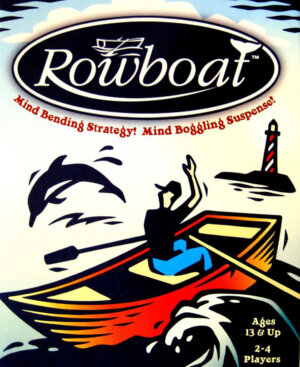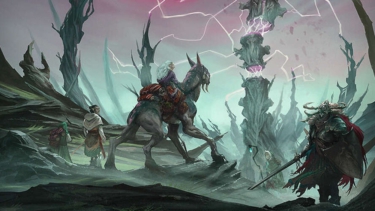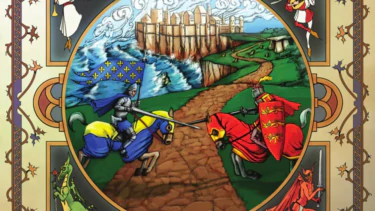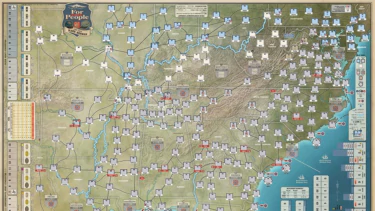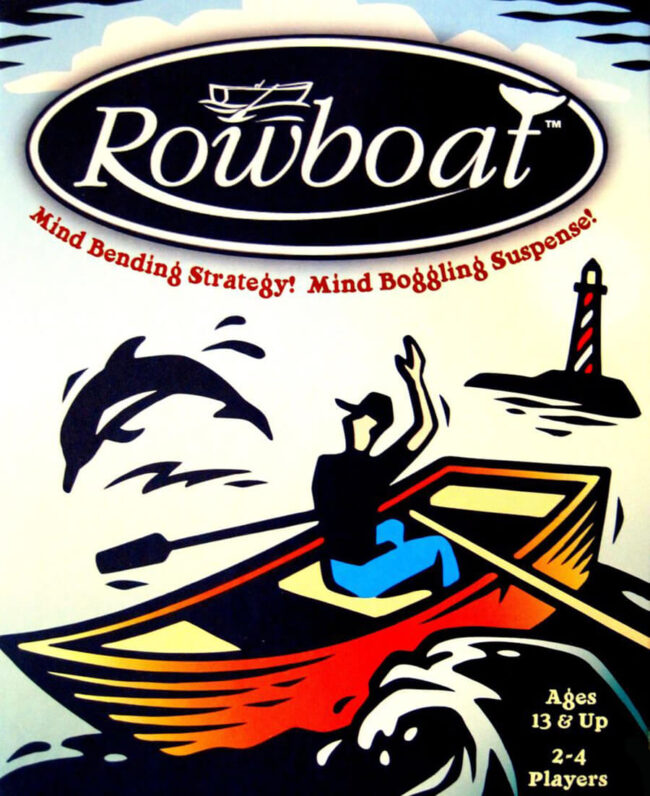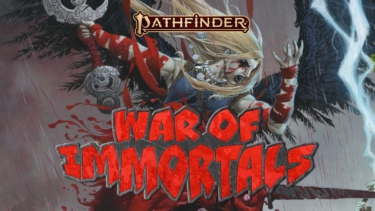Publisher: Moosetache Games
Designer: John Montague
Artist: Sophie Kittredge
Genre: Spades-like card game
Year: 2009
Players: Two to four players
Ages: 13+
Playing time: 60 Minutes
MSRP: $12.50
Rowboat is a card game very, very similar to Spades, although there are differences thrown in to add a new dimension of strategy to the game. The most difficult aspect of the game is that the suits and face cards have been redone for the nautical theme. So you have to get used to using maps, shells, oars, and waves as the suits instead of hearts, spades, diamonds, and clubs. You also have Anchors instead of aces, but they are the lowest value card in a suit. The face card replacements from 10 to king are (D)olphin, (M)ermaid, (S)eeker, and (W)hale. The nice thing at least is that they are in alphabetical order by value: D, M, S, W.
Once you get past that, it is fairly simple. A lot of the strategy comes from the mechanic in this game where you deal out a number of cards in a line until you get at least one of each suit on the table, or a max of 12 cards (this is called the Tide). Each of these cards will represent the trump suit in one round of play. The total number of cards represents the number of rounds in the hand. So if you ended up dealing out 8 cards in the Tide, you deal 8 cards to each player and you are ready to go. Look at the first card from the ones you dealt out on the table, its suit is the trump suit for this round. Each player plays a card, and the one who plays the strongest card wins the round (the trick) and takes the played cards. This will net them 10 points in scoring after the hand is over. Play then proceeds to the next card in the Tide, and is repeated for each card in the Tide with the players winning tricks and taking them into their pile. When the last card in the Tide is collected, the hand is over, the points are tallied (remember, 10 points per trick taken), and a new hand is started. The first player to 200 points wins the game.
Where is the strategy? Let me break it down:
Normally, if you have a card in the trump suit you must play it. In Rowboat however, if you have a card that is the same value and color of the trump card (Black 3 trump card, and you are holding a another black 3) it beats almost everything, and you can hold on to it if there is a card further down the line of trump cards that it can be played on. So let’s say that you see in round 5 there is a black 3, and you are holding a black 3. You are allowed to save that card for play in round 5, even if you are normally supposed to play it in an earlier round. This allows you to plan ahead a bit, and get an idea as to which rounds you are pretty sure you will win.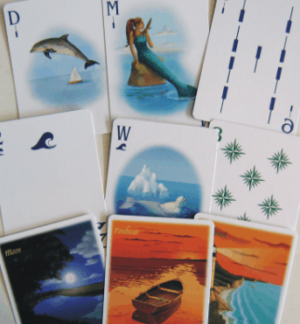
There are 3 special cards that also add another dimension to the game as well. Each player receives a set and they are kept separate from the playing cards. You can only use each once per game.
Rowboat: The rowboat beats any other card, and cannot be beat by another rowboat. So you are basically guaranteed a win in a selected round. If played properly, it can be used to distinct advantage.
Lighthouse: If you play the lighthouse, you can look at the other player’s hand for the length of one sand timer. If you have a brain capable of processing that info it adds a huge amount of strategy to the game. I however do not, so we played a variant where if you played the lighthouse, you automatically force the other player to play their card first.
Moon: You can use the moon to choose the number of rounds you want in a hand (between 4 and 12), rather than dealing out cards for a random amount of rounds in the hand. I’m still exploring the strategic possibilities of this card, but it does allow you to take a nice break if you’ve had 2 big hands in a row and want a simple one.
Bidding: Finally, there is bidding. To get the full flavor of the game you need to try the bidding mechanic. After several plays with this option, I opted to leave it out, as it added a level to the game we did not enjoy. You must guess before the first round begins how many tricks you will take in that hand. So it is important to determine how many trick you are pretty sure you will win right away. If you guess too high, your score is negative rather than positive. If you guess too low, you accumulate bags at a rate of 1 bag per trick you were off by, leading to a penalty of 100 points once you receive 5 bags (cumulative). If you like this kind of option then you should use it. I felt it actually took away from the game. We found it more annoying than enjoyable, and decided to do future plays without the bidding mechanic.
The cards are glossy standard card stock and the artwork is well done, it reminds me of the “Hardy Boys” artwork, or something you’d see hanging in your bathroom. I would recommend this game for those who like standard card games (like Hearts or Spades), but want more strategy – especially if you enjoy the nautical theme.
- A Dungeon Delve for Kids?: A Review of Dungeon! - Oct 24, 2022
- Better, Stronger, Faster | Descent: Journeys in the Dark Second Edition Reviewed - Oct 23, 2022
- Your Planet is Doomed!: Invasion from Outer Space Reviewed - Oct 22, 2022



